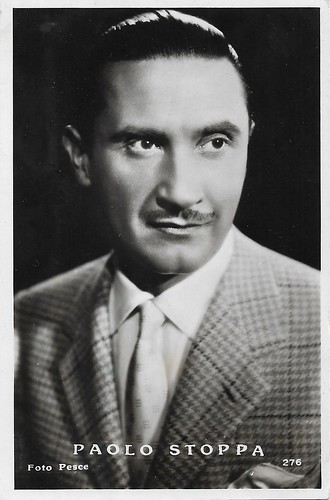
Italian postcard by A. Terzoli, Roma / Stabilimenti Angeli, Terni, no. 276. Photo: Pesce.
Italian character actor Paolo Stoppa (1906–1988) is best known for his stage work with director Luchino Visconti. In a career of more than 50 years, he also appeared in such cinema classics as Miracolo a Milano (1951), Il Gattopardo (1962), and Once Upon a Time in the West (1968).
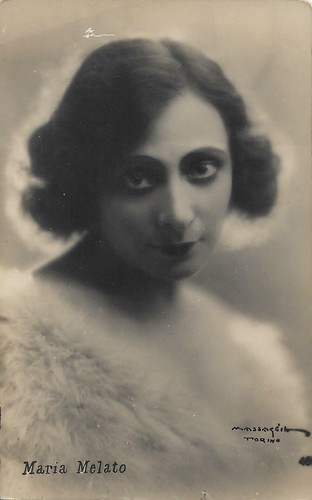
Italian postcard by Ballerini & Fratini, no. 31. Photo: Massaglia, Torino.
Italian actress Maria Melato (1885-1950) appeared in the theatre, on the radio, and in the cinema. Her films included Ritorno/Return (1914), Anna Karenina (1917), and Il volo degli aironi/The flight of the herons (1920). Unfortunately, all of her films are considered lost.
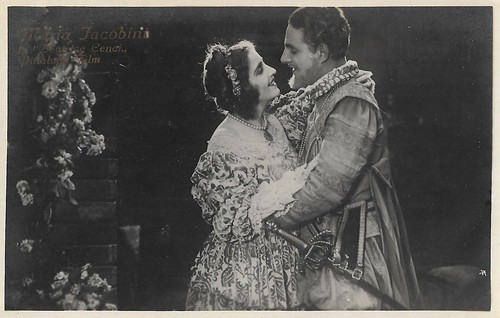
Italian postcard by G.B. Falci, Milano, no. 663. Photo: Pittaluga Films. Maria Jacobini as the title character and probably Gino Talamo as her lover Olimpio Calvetti in Beatrice Cenci (Baldassarre Negroni, 1926). Jacobini stars in this film based on the true events of the murder of the cruel, violent, frugal and rapist Count Francesco Cenci, by his daughter Beatrice, her lover Calvetti, the carpenter nicknamed The Catalan, Beatrice's stepmother Lucrezia, and Beatrice's brothers Giacomo and Bernardo. Pope Clemens VIII shows no clemency despite his name, and all but the youngest brother Bernardo are killed.
Among the Italian divas, Maria Jacobini (1892-1944) was an island of serenity, as film historian Vittorio Martinelli expressed it. She was the personification of goodness, of simple love. Her weapon was her sweet and gracious smile. However, in some Italian, and later also in German films, she could as well play the vivacious lady, the femme fatale, the comedienne, the hysterical victim, or the suffering mother or wife.

Italian postcard by IPA CT Duplex, V. Uff. Rev. St. Terni, no. 9500. Photo: Milano Films. Luigi Duse as the title character in Jacopo Ortis (Giuseppe Sterni, 1918). Caption: Jacopo admires the medallion of Teresa.
Italian stage and film actor Luigi Duse (1857-1930) was parented to the Duse stage actors family to which also famous stage actress Eleonora Duse belonged.

Italian postcard by IPA CT Duplex, V. Uff. Rev. St. Terni, no. 9504. Photo: Milano Films. Paola Borboni as Teresa and Luigi Duse as the title character in Jacopo Ortis (Giuseppe Sterni, 1918), Caption: Jacopo in ecstasies over the sweet sound of the harp.
Paola Borboni (1900-1995) was one of the greatest stage actresses of Italy who also played in many films. She was often heard on the radio and seen on television, but her true passion was the stage.
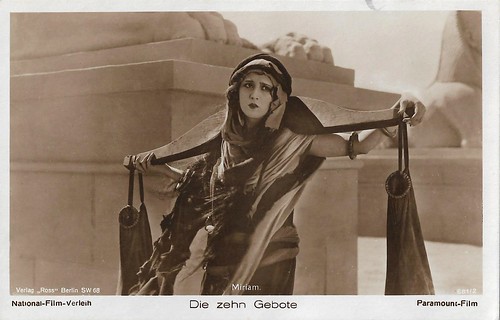
German postcard by Ross Verlag, no. 681/2. Photo: Paramount-Film / National-Verleih. Estelle Taylor as Miriam, sister of Moses in The Ten Commandments (Cecil B. DeMille, 1923). Caption: Miriam.
Estelle Taylor (1894–1958) was an American actress, singer, model, and animal rights activist. With "dark-brown, almost black hair, and brown eyes", she was regarded as one of the most beautiful silent film stars of the 1920s.
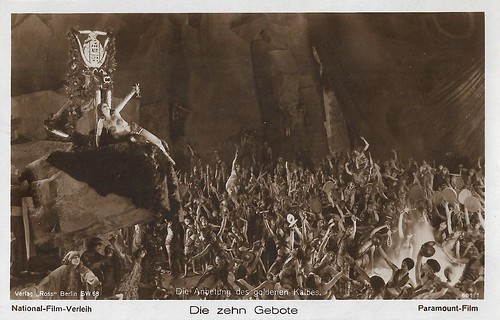
German postcard by Ross Verlag, no. 681/1. Photo: Paramount-Film / National-Verleih. Estelle Taylor as the woman who embraces the Golden Calf, in The Ten Commandments (Cecil B. DeMille, 1923). Caption: The Adoration of the Golden Calf.

Italian postcard in the Cines-Pittaluga series by Ed. G.B. Falci, Milano, no. 42. Photo: Cines-Pittaluga. Armando Falconi (the man with the bandage) as count Armando, and possibly left Giuseppe Pierozzi as the little creditor and Arturo Falconi as Armando's best friend Paolino in Patatrac (Gennaro Righelli, 1931).
Armando Falconi (1871-1954) was an Italian stage and screen actor. Though he was foremost a theatre actor and comedian, he had a prolific career as a comedian in Italian cinema of the 1930s and early 1940s.
Arturo Falconi (1867-1934) acted in some 11 Italian silent films between 1916 and 1918, most of which were directed by Guido Brignone and starring Lola Visconti-Brignone and Falconi himself. He returned to the sets in 1931 for 8 more films between 1931 and 1935, starting with Patatrac (1931).
Little Giuseppe Pierozzi (1883-1956) was a typical character actor in Italian who acted in some 125 Italian silent and sound films between 1917 and 1954.
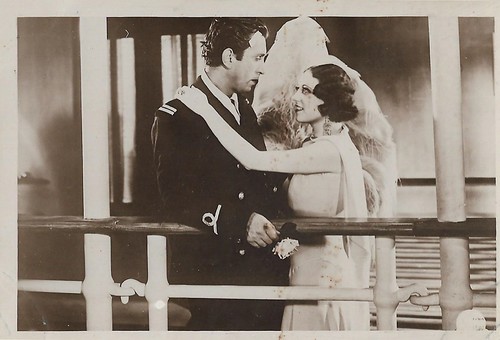
Italian postcard by Ed. G.B. Falci, Milano. Photo: Cines-Pittaluga. Carlo Fontana and probably Enrica Fantis in the Italian early sound film Vele ammainate/Lowered Sails (Anton Giulio Bragaglia, 1931). The front and back of the card don't indicate the film title but we managed to identify it. See also our blog post on the film at European Film Star Postcards.
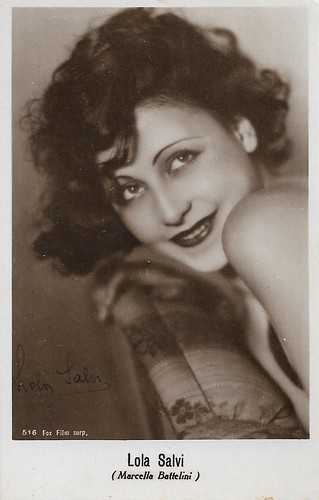
Italian postcard by Ed. G.B. Falci, Milano, no. 516. Photo: Fox Film Corp. Lola Salvi as Marcelle in Plastered in Paris (Benjamin Stoloff, 1928). The film was shot as a silent production, but afterward, a soundtrack with music was added.
Lola Salvi was an Italian actress, whose real name was Marcella Battelini. Born in Trieste, Battelini won a beauty contest by Fox in Italy. Her mother accompanied her to Hollywood, where she had a female lead in Plastered in Paris (1928), a comedy about two American veterans who visit Paris and end up in the French Foreign Legion. The film clearly mocked Foreign Legion dramas such as Beau Geste, while the two male leads were caricatures of the Jew with the big nose and the dumb Swede. Salvi then was cast as an Italian girl in her first sound film, Irving Cummings, and Raoul Walsh's In Old Arizona, Fox's first all-sound film, but her role was small and uncredited. After another small role, as a maid in Thru Different Eyes (John G. Blystone, 1929), Fox ended her contract.
The site Bizarre Los Angeles notes that afterward, she agreed to costar in a film by another Fox outcast actor, the former Brazilian journalist Olympio Guilherme, who also had been hired by Fox after winning a contest: "Guilherme decided to make his own film. Using hidden cameras on the streets of Los Angeles, he and Salvi interacted with each other as well as other Angelenos, who didn’t know they were being filmed. As a result, he completed Hunger, a drama that depicted the hardships of Latino Americans trying to survive in Los Angeles in the late 1920s." The Spanish title of the film is Fome (1929).
Sources: Bizarre Los Angeles and IMDb.
No comments:
Post a Comment